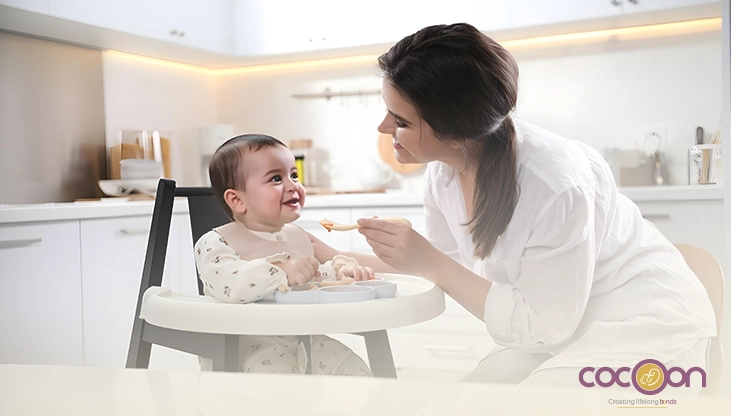Introduction
One of the most significant jobs as a parent is feeding your baby, yet it can be confusing too. You might ask yourself: "When do I introduce solids?" or "What can I feed my baby now safely?" Don't worry—you are not alone. Other parents wonder the same thing, particularly once their baby hits each new milestone.
This blog is your comprehensive baby feeding chart, giving you a month-by-month guide to understanding what to feed your baby at what age, when to introduce foods, and how to plan a healthy and safe baby feeding routine.
Why Does Baby Feeding Change Every Month?
Infants develop rapidly during their first year. Their stomach capacity, digestion, chewing efficiency, and need for nutrients all shift quickly. During the first six months of life, babies require only milk. But thereafter, they gradually learn to take solids, chew soft foods, and later sit down to full family meals.
That's why it is useful to use a baby food chart that varies with the age of your child. Using this chart, you will be able to provide the correct food at the correct time, ensuring a healthy growth rate and minimizing the risk of food allergy.
0 to 6 Months: Is Milk Sufficient for an Infant?
Yes, definitely. During the first six months of life, your baby requires only breast milk or infant formula. This supplies all the energy, protein, vitamins, and liquid your baby requires. No other food or liquid is required at this time—not even water.
If you're breast-feeding, nurse your baby on demand—about every 2 to 3 hours. Formula-fed babies nurse every 3 to 4 hours. Feed your baby day and night as needed.
Breast milk contains antibodies that keep your baby from getting sick. Formula, properly made, is nutritious and safe as well. Avoid giving solid foods in the first 6 months, but if your pediatrician suggests, you can opt for it.
6 Months: How Do I Begin Solids for My Baby?
By 6 months, most babies are ready to start solid foods. The following are signs that your baby is ready to start solid food: he or she can sit with support, holds head steady, and is interested in food.
Start with single-ingredient, soft foods in mashed or pureed form. Start with iron-containing foods such as iron-fortified rice cereal, mashed moong dal, or cooked and soft vegetables like pumpkin and carrot. Mashed apples and bananas are good fruits.
Introduce one new food at a time and after 2 to 3 days introduce another. This way, you can observe for any allergic reactions in the form of rashes, diarrhea, or vomiting.
Provide small quantities—only 1 or 2 teaspoons at a time—and build up slowly. Don't forget, milk is still your baby's staple food. Solids are mere practice at this point.
7 Months: Can I Add More Flavors and Textures?
Yes. When your baby becomes accustomed to the initial foods, you may introduce a greater variety. Your baby is now able to tolerate slightly thicker consistency and might enjoy experimenting with various flavors.
Continue to provide breast milk or formula as the primary diet. In addition, give pureed fruits such as pear, chikoo, or papaya. Steamed and mashed vegetables such as peas or potatoes are also okay.
Soft suji porridge, oat porridge, or ragi porridge, and watery dal with rice are also options. If the baby is not allergic to eggs, you may give mashed or hard-boiled egg yolk in small quantities.
Two meals of solids daily are sufficient at this point, with breast milk or formula afterward. Begin introducing small amounts of water at meals.
8 Months: Is It Time for Finger Foods?
Yes, the majority of babies at 8 months begin to grab food with their hands and are able to tolerate soft finger foods. This is when self-feeding (under supervision) should be started, even if it is messy.
You can now offer soft bits of steamed carrot, peeled banana, or cooked apple for your baby to grip and chew. Refrain from hard food or choking food.
Your baby can have well-cooked rice, khichdi, soft paneer, and roti dipped in dal at this age. Soft foods with tiny lumps that are gently mashed are acceptable. Continue milk feeds, typically 4 to 6 times daily.
A good routine is 2 solid meals, 1 snack (such as fruit), and regular milk feeds.
9 Months: What Does a Baby's Diet Look Like Now?
Your baby is more active and interested in food at 9 months. This is a good time to provide more texture and variety of foods. Now you can attempt soft idlis, upma, or pieces of dosa soaked in water or milk.
Soft foods such as mashed fruits, e.g., mango or watermelon, can be provided. Plain cooked pasta, mashed potato with butter, and scrambled egg are also good. Ensure all are soft and chewable.
Your baby may have 3 solid meals and 1 or 2 snacks during the day. Milk feeds will decrease but still play a critical role. Allow your baby to experiment eating from a spoon and cup—it's part of learning.
10–11 Months: Can My Baby Eat What We Eat?
Yes, with some modifications. Your baby is now able to eat most family foods if they are soft, not spicy, and not salted or sugared. It's a good time to take your baby to the family table to observe and learn.
Provide tiny amounts of dal-chawal, sabzi mashed up, paneer cubes, curd, or soft rotis with ghee. Avoid high-salt, deep-fried, very hot, or sweet foods. Provide the food low in salt.
Boiled eggs, homemade soups, soft fruits, and paneer cubes are all good choices. Please note that your baby's diet is now composed of 3 meals, 2 snacks, and 2 to 3 milk feeds.
Make them feed themselves more frequently, even if they make a mess. This is an important phase in developing eating habits.
12 Months and Older: Is My Toddler Ready for Family Dinners?
Yes. After your baby is one, they are a toddler and can eat the same as the rest of the family—except in a few instances. They require more energy and nutrients from food now, and milk is only an added supplement.
You can provide whole milk in a cup now, along with solid food. At this age, your baby can have roti, rice, sabzi, dals, eggs, soft chicken, and fruits. Cut foods into small pieces and make sure everything is soft to chew.
Encourage your child to feed themselves. Do not provide snacks continuously. Plan correct meals and snacks to create a healthy routine.
Keep on avoiding added sugar, processed foods, soda, and whole nuts (for risk of choking) until your child is older.
What Foods Should I Avoid in the First Year?
It is as crucial to know what not to feed as what to feed. Avoid:
- Honey (can cause infant botulism)
- Cow's milk as a primary beverage prior to 12 months
- Salt and sugar
- Junk food and fried foods
- Raw or undercooked eggs and meats
- Whole nuts (risk of choking)
- Tea, coffee, and fizzy drinks
If there is a history of allergies in your family, talk to your doctor before introducing wheat, dairy, eggs, or peanuts.
What's a Good Baby Feeding Schedule for Each Day?
Here's an approximate idea of a baby eating schedule according to age: 6–7 months: 2 solid meals + breast/formula feeds every 3–4 hours 8–9 months: 3 meals + 1 snack + milk feeds 3–5 times/day 10–11 months: 3 meals + 2 snacks + 2–3 milk feeds/day 12+ months: 3 main meals + 2 snacks + 1–2 milk feeds/day Keep in mind that each baby is unique. Don't be concerned if your child has less to eat on some days—this is normal.
What's a Good Baby Feeding Schedule for Each Day?
Here's an approximate idea of a baby eating schedule according to age:
- 6–7 months: 2 solid meals + breast/formula feeds every 3–4 hours
- 8–9 months: 3 meals + 1 snack + milk feeds 3–5 times/day
- 10–11 months: 3 meals + 2 snacks + 2–3 milk feeds/day
- 12+ months: 3 main meals + 2 snacks + 1–2 milk feeds/day
Keep in mind that each baby is unique. Don't be concerned if your child has less to eat on some days—this is normal.
How Do I Know If My Baby Is Eating Enough?
A few signs that your baby is eating enough are:
- Steady weight gain
- Active and playful behavior
- Wet diapers frequently (at least 5–6 per day)
- Interest in food
- Sleeps well
Don't compare your baby to others. Pay attention to your child's own development and trust your instincts.
When Should I Talk to a Doctor?
Talk to your pediatrician if:
- Your baby is not eating properly from a few days
- Your baby is losing weight or failing to gain
- You observe rashes, vomiting, or diarrhea following a food
- Your baby is not urinating or having a bowel movement regularly
Early intervention can avoid nutritional deficiencies and food allergies.
Conclusion
You do not have to stress when feeding your baby. This baby food chart can be your guide, but keep in mind that babies do not obey rules. Some consume more, others consume less. Some will try anything, others are finicky.
Keep meals happy, relaxed, and loving. Distract not with phones or the television at the table. Engage your baby in the exploration of food, chewing, swallowing, and enjoying the process.

















